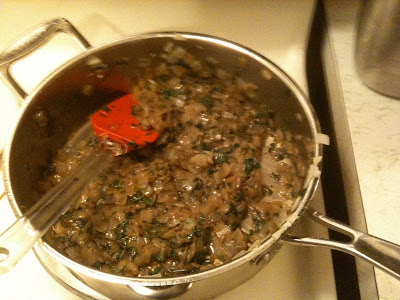Alrighty, then. I suppose it's time to get back into the saddle and take the reins. I honestly can't even remember when I made this bread, it was so long ago. Oops. Anyway, we were at Bill's parents' house for the weekend. One of his childhood friends, one Miss Elizabeth Lacher, was moving that weekend, and we decided to make her a loaf of bread as a housewarming present. I chose this based on her previous love for a loaf of focaccia we gave her and her enjoyment of a bread she can just keep by her bed and eat a pinch whenever she likes. That's my kinda girl.
Seeing this bread in the book, it seemed perfect. It was loaded with extra ingredients that made it more than just "a piece of bread." The meat and cheese made it seem more like a meal in itself. It turns out that the bread has quite a history to it as well. Explained in the book as the Italian version of brioche, this bread is actually an important Easter bread in Italy. The bits of meat, traditionally salami, represent an ancient pagan ritual involving the sacrifice of pigs to ensure increased fertility in both women and the land. The cheese, traditionally pecorino, represents the innocence of Christ. The butter doesn't necessarily represent anything, but I like it. A lot.

Step one: a one hour sponge. Bread flour, water and buttermilk go into the bowl. One hour later, a bubbly mess. Meanwhile, dice and fry the salami.
Step two: Flour, salt, sugar, eggs and the sponge come together to make a dry, crumbly, unappealing dough. A stick and a half of butter go in, making something much nicer.
In goes the meat and some diced up cheese, followed by an hour and a half of rising.
One of the suggested ways to bake these was in paper bags, a traditional form of baking. We were about to relent and bake them in the loaf pans but found some paper bags in the bottom of a drawer at the last moment. Again, another rise.
And, voila! Two beautiful loaves cresting over the tops of the bags. The bag was removed from one of these about ten seconds after the picture was taken so we could take very cautious bites from the steaming hot bread. The taste was unbelievable. Between the butter and the cheese, the crumb was incredibly smooth and creamy. The salami gave it both a flavor kick and a nice salty twang.
The next day, the housewarming gift was well-received, and we had devoured most of our loaf. This bread is great when you want something to snack on, as it really hits all the taste sensations I like. Two big thumbs up on this one!
Casatiello? Check.
Next? Portuguese Sweet Bread.





















































